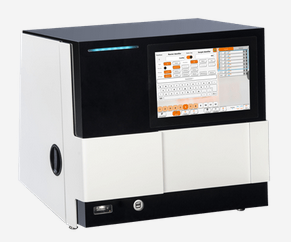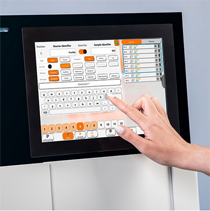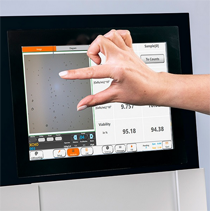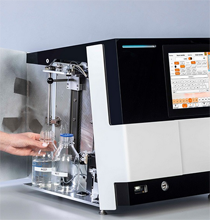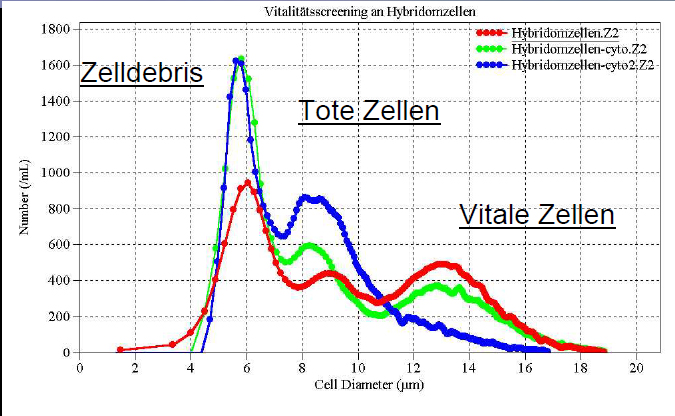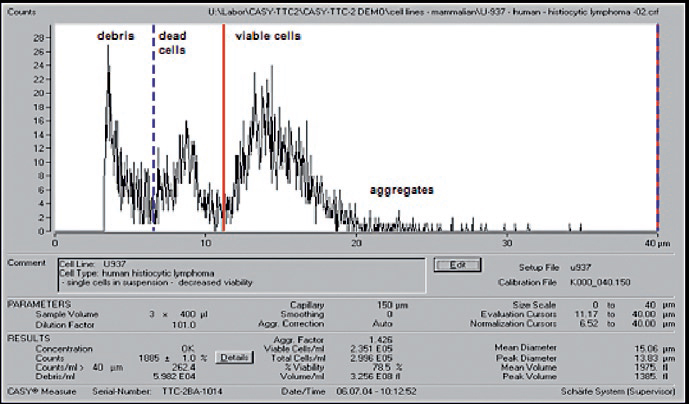Automated Cell Counters - an Overview
|
Automated cell counting has been on the rise for several years and is the current state of the art, at least in the industry. The reason behind this is due to the advantages of automated counting over the classical counting with a Neubauer chamber or Thoma chamber. On this page we try to give an overview of automated cell counting and present a comparison of counter suppliers. For those who want to buy a counter, we want to point out advantages and disadvantages and provide support in choosing a cell counter. Of course, we can only provide the information we receive from manufacturers and users. If you have had positive or negative experience with your counter, we are looking forward to your feedback or comments by mail or phone. Cell counting is an essential basis for controlling cellular growth via growth curves. For this reason, counting methods and automated cell counters are topics in our Cell Culture Basic Course and in the advanced training courses Cell Culture Bioassays and QA in Cell Culture. |
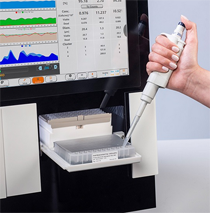 |
Topic of this cell counter overview
Detailed overview counters
|
Automated Counting
A large array of counters is available at the moment. The types range from counter "only" to more sophisticated machines that may perform additional functions. Below, you can see a comparison of machines divided into measurement types including the counters ViCell, Luna, Casy, Cedex, 4BioCell, EVE, TC20, Cellometer, CellDrop, Luna, Countess, Exact FL Fluidlab, Adam, Nucleocounter, Ampha and Scepter. Please note, that we have decided not to include cell monitoring systems.
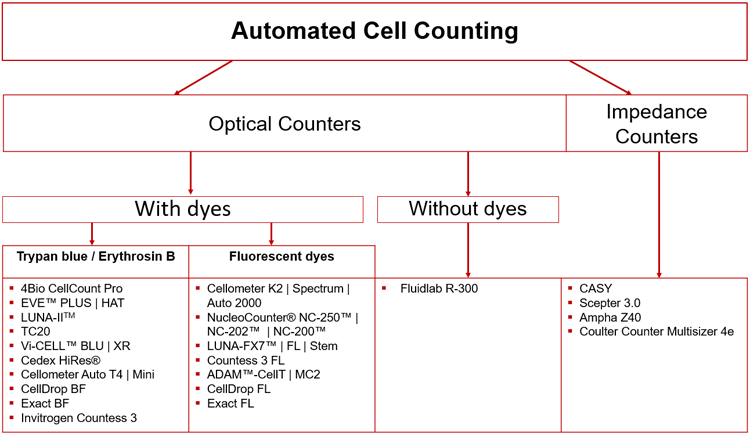
Advantages of Automated Cell Counting
Counting with the Neubauer chamber is still performed and works well, but automated counting is the state-of-the-art technology for several advantages. The most important is the poor standardizability of the manual analysis due to subjective decisions while counting. The most important advantages are listed below.
- Reproducible, operator-independent and objective measurement
- Work simplification with a high sample throughput
- Additional measurement parameters such as size, aggregation factor and homogeneity of cells
- Automatic calculation of cell count/mL and % live cells
- Usually statistically better data because larger volumes of cell suspensions are counted
- Partially live/dead determination of cells without toxic trypan blue (not all counters)
- Depending on the instrument, combinations of different measurement methods such as fluorescence-labeled cells or trypan blue are possible
- Easy to validate
Disadvantages of Automated Cell Counting
- High to medium investment costs
- Maintenance costs
- Depending on device cheap to expensive consumables
- Plastic waste to to counting chambers
- Not all counters are suitable for all cell types
Purchase decision making - which cell counter is best for whom
Some cell counters are only suitable for larger companies or pharmaceutical companies because the invest and the cost of consumables is to high. Some cheap counters on the other hand are not precise and the counting chambers are extremely expensive. So, before purchasing a counter, think, calculate and test your favorites. The most important factors are:
- Cost of device
- Cost of consumables
- Cost of maintenance, repair, transport costs
- Volume counted (precision)
- Precision of live/dead counts (MUSE counts erythrocytes, Scepter has poor viability measurements)
- Cell numbers per mL countable (important for primary cells, stem cells)
- Precision when counting aggregates if applicable
- Back-up counting method
- Cell size measurements possible
- Do you have other fluorescence measurements that the device could perform (then a FL device would be good)
How much do you count
For an average research lab with 20-40 counts per week, probably the best choice is a trypan blue/erythrosin B chamber counter. These are sufficient and precise enough and do not require maintenance. Do not opt for a Scepter because its so cheap. The counting chamber costs 2,5 Euro per count. If you count a lot the price of the chambers e.g. 40 ct up to 2,5 adds up. Now devices without counting chamber become more interesting. On the other hand, check what maintenance chamber-less devices need. Cleaning storage etc.
If you are in a pharmaceutical core facility and you count 40 times per day automated high throughput devices and speed of counting become more important. Also chamber-less systems are now a good idea to look at. Be prepared for high maintenance costs with the ViCell and Cedex. GMP conformity as well as CFR21 conformity are a necessity, ask for the price of the GMP software.
How precise does the count have to be
Counting as any method is as good as the sample size is large. The more volume you count, the better the precision (statistics). So check the counted volume (not counting chamber volume) for the counter you are interested in. Also check whether double or triple counts are possible with only one chamber/sample. Also note, for some machines such as the ViCell you can decrease to number of counts/images. If you do so, the count is faster but less precise. For pharmaceutical companies, precision is very important and should be a key decision argument.
What is your back-up counter
In case your counter is broken, blocked or similar, you need a replacement method. In GMP, this method has to be validated as being comparable. Logically, the easiest way is a trypan blue counter and a Neubauer chamber as a back-up.
Brief overview of cell counter manufactures and suppliers
| Cell Counting System | Manufacturer | Device |
| Optical /microscopy-based counter | ||
| Bright-field microscopy | 4 Bio Cell | 4Bio CellCount Pro |
| Roche CustomBiotech | Cedex HiRes® Analyzer | |
| Logos Biosystems | LUNA-II™ | |
| DeNovix | CellDrop BF | |
| Nexolom | Cellometer Mini | |
| Cellometer Auto T4 | ||
| Bio-Rad | TC-20 | |
| CytoSmart | Exact BF | |
| Thermo Fisher Scientific | Invitrogen Countess 3 | |
| NanoEntek | EVE™ Plus | |
| EVETM HT | ||
| Beckman Coulter | Vi-Cell™ BLU | |
| Fluorescence microscopy-based counters | ||
| DeNovix | CellDrop FL | |
| ChemoMetec | NucleoCounter® NC-250™ | |
| NucleoCounter® NC-202™ | ||
| NucleoCounter® NC-200™ | ||
| CytoSmart | Exact FL | |
| Logos Biosystem | LUNA-FX7 | |
| LUNA-FL | ||
| LUNA-STEM | ||
| Nexolom | Cellometer Spectrum | |
| Cellometer K2 | ||
| Cellometer Auto 2000 | ||
| Thermo Fisher Scientific | Countess 3 FL | |
| NanoEntek | Adam -MC2 | |
| Adam -CellT | ||
| Holographic microscopy | Anvajo | Fluidlab R-300 |
| Impendance based counter | ||
| Amphasys | Ampha Z40 | |
| OMNI Life Science Bremen | CASY | |
| Beckman Coulter | Multisizer 4e | |
| Merck Millipore | Scepter™ 3.0 | |
Optical cell counters
Basically, the optical cell counters are small, automated microscopes optimized for the purpose. The cells are injected into a flow cell or counting chamber and evaluated with the aid of a digital camera and intelligent image evaluation software.
|
The devices available on the market differ fundamentally in their equipment. Classic systems where the user can choose from different staining agents and sample preparation:
are available on the market in a wide variety. In the meantime, there is also a device that uses
. |
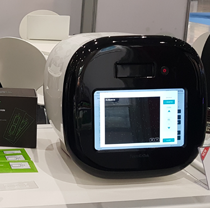 |
Bright-field Microscopy Cell Counters - closest to the Neubauer chamber
|
These counters use the classical method of cell counting as we know it from the Neubauer chamber. However, the process of counting is automated. The counter takes one or more photos and then automatically evaluates the cells in the photos. The counting chambers cost about 80 ct to 2.5 euros. So you should compare exactly what the devices and the disposable chambers cost and how much you count. This evaluation is not trivial and must be set for each line. Therefore, one should make sure that one gets a good introduction and during this one should also set the first measurement settings. For live/dead counts (vitality), the sample is mixed with trypan blue or erythrosin B, pipetted into a special counting slide and analyzed. Both stain dead cells because their cell membrane is permeable to the dye, while living cells are not stained. Since trypan blue is toxic to cells, living cells will also be stained if the sample is not analyzed within a certain time frame. Do not allow samples mixed with trypan blue to stand for more than 5 minutes to avoid false positive results. Therefore, when selecting the cell counting instrument, it is important how quickly after mixing with trypan blue the sample is measured. Erythrosin B is non-toxic so its is preferable to trypan blue. Erythrosine B stains dead cells pink/purple. As with trypan blue, the basis is damage to the cell membrane. |
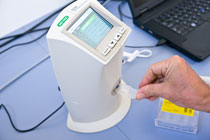 |
What is better: trypan blue or erythrosin B ?
| Trypan blue | Erythrosine B | |
| What is stained | Dead cells + serum proteins | Dead cells only |
| Concentration used | >400μg/mL, 1:2 or 1:10 | >5μg/mL |
| How fast are dead cells stained ? Sensitivity | >50min | 1min |
| Color of dead cells | blue | pink |
| Toxicity | Toxic (carcinogenic) | Not toxic, food additive |
| Toxicity while staining. Can you prepare many samlples | Toxic, sample storage max. 5 min | Non toxic for periods of over 2h |
4Bio CellCount Pro
| Supplier | 4BioCell GmbH & Co. KG or Sales Partner worldwide |
|
| Production site | Germany | |
| QMS | ISO 9001 | |
| Category | Pharma, research, cell culture, high throughput, GMP | |
| Imaging method | High-resolution camera moves over fixed measuring chamber with sample & takes 23 pictures, AI-based image analysis gives measured values for:
|
|
| Resolution (pixel) | Acquisition of 23 images, each 1500x1500 px, depicting the entire measurement chamber | |
| Cell count / mL | Yes | |
| Viability | Yes, with trypan blue or alternative (safe) dye erythrosin B | |
| Size distribution | Yes (read out as an average value per image and overall average value from 23 images) | |
| Aggregation analysis | Determination of the aggregate number and distribution (2, 3, 4 or larger than 4 clusters) per image and as an average of all 23 images | |
| Sample volume | 100 µL from one sample and 200 µL for a duplicate determination of a sample | |
| Counted volume | 0.225 µl are evaluated per image. High Precision 23 images x 0.225µL = 5.175µL Medium Precision 10 images x 0.225µL = 2.250µL Low Precision 3 images x 0.225µL = 0.675µL | |
| Measuring time | approx. 2-3 minutes even at high concentrations | |
| Measurement accuracy | reproducibility | Measurement accuracy < 5% | |
| Cell size range | 2-40µm | |
| Cell concentration | 5x104 – 2x107 cells/mL undiluted, automatic dilution up to 1:5 possible directly on-board | |
| Multi determination | Automatic double determination from one sample possible | |
| Suitable for | Cells, cell lines | |
| Price | No information | |
| Consumables |
|
|
| Maintenance |
|
|
| Introduction |
|
|
| GMP complaint |
|
|
| Data analysis |
|
|
| Computer system & specification |
|
|
| Disadvantages | Not for single cell counts, low throughput | |
| Advantages |
|
TC20TM Automated Cell Counter from BioRad
| Distribution through | BioRad | |
| Cell count/mL | Yes | |
| alive/dead | Yes, with trypan blue | |
| Size | Yes, as an average value read from a photo | |
| Aggregation factor | No | |
| Sample quantity | From approx. 20µL | |
| Counted volume | Comparable to the new builder's chamber, no information from the manufacturer. | |
| Multiple determination | No | |
| Measuring range | 5 - 50µm (T4) | |
| Suitability | Cell lines and primary cells that are not too large (T4) | |
| Measuring time | 30s | |
| Price | List price approx. 3,995 euros | |
| Consumables | Medium (approx. 72ct/count)
|
|
| Maintenance | No calibration, cleaning or maintenance | |
| Advantages |
|
|
| Disadvantages |
|
Fluorescence Microscopy Cell Counters
In principle, these systems function in exactly the same way as the chamber systems with trypan blue. However, the cells are stained with fluorescent dyes. This type of staining avoids the problem of false positive staining with trypan blue when the samples stand longer. Thus, one can prepare several samples, let them stand longer and then measure them.
If the instruments measure green fluorescence, they can of course also be used to measure transfection efficiencies and the like. However, this function is of course clearly reflected in the price. Therefore, you should only buy such a device if you regularly perform fluorescence measurements in addition to cell counting or if other measurement principles produce poor results with your own cells.
Luna fl Dual fluorescence Cell Counter
| Distribution through | Logos Biosystems | |
| Cell count/mL | Yes | |
| alive/dead | Yes, with trypan blue or (acridine orange and propidium iodide). | |
| Size | Yes, as an average value read from a photo | |
| Aggregation factor | No, but can count out clusters | |
| Sample quantity | From approx. 15µL | |
| Counted volume | Comparable to the new builder's chamber, no information from the manufacturer. | |
| Multiple determination | No | |
| Measuring range | 3 - 60µm | |
| Suitability | Cell lines and primary cells that are not too large | |
| Measuring time | 7s | |
| Price | List price approx. | |
| Consumables | Medium (approx. 50ct/count) Disposable counting chambers (non-rinsable) Trypan blue | |
| Maintenance | No calibration, cleaning or maintenance | |
| Advantages | Autofocus For chamber systems favorable chambers | |
| Disadvantages | Higher consumables costs than capillary systems Fluorescent dyes are toxic and must be disposed of (incineration) Significantly worse statistics due to the smaller counting volume Determination of counting criteria for new lines more complex than for capillary systems |
Cellometer Vision from Nexcelom
| Distribution through | Nexcelom | |
| Cell count/mL | Yes | |
| alive/dead | Yes, with fluorescence (acridine orange/propidium iodide). | |
| Size | Yes, as an average value read from a photo | |
| Aggregation factor | No, but can count clusters | |
| Sample quantity | From approx. 25µL | |
| Counted volume | Comparable to the new builder's chamber, no information from the manufacturer. | |
| Multiple determination | No | |
| Measuring range | 5 - 60µm | |
| Suitability | Cell lines and primary cells that are not too large (T4) | |
| Measuring time | 30s | |
| Price | List price approx. 35,000 euros | |
| Consumables |
|
|
| Maintenance | No calibration, cleaning or maintenance | |
| Advantages |
|
|
| Disadvantages |
|
Comparison of capillary systems based on trypan blue
This system is a mixture of the capillary system and the chamber-based counting. No counting chamber is needed, but a photo is taken and evaluated in the instrument as in the systems below. Due to the suction principle, the accuracy is lower than in the pure capillary systems, which have the measuring pore directly in the cell suspension. Due to the automatic aspiration and mixing with trypan blue in the instrument, the problem with false-positive staining of cells with trypan blue during longer standing times is circumvented.
ViCell Cell Counter
| Distribution through | Beckmann Coulter | |
| Cell count/mL | Yes | |
| alive/dead | Yes, with trypan blue | |
| Size | Yes, as an average value read from a photo | |
| Aggregation factor | No | |
| Sample quantity | From approx. 500µL | |
| Counted volume | ||
| Multiple determination | 1-fold, 2-fold and 3-fold from one sample | |
| Measuring range | 2-70µm | |
| Suitability | ||
| Measuring time | 150s | |
| Price | List price approx. | |
| Consumables | Medium to favorable:
|
|
| Validation | Device and software are validated. Software is 21CRF compliant. Validation aids available. Validated consumables. | |
| GMP suitability | Yes. Used in many GMP laboratories. | |
| Autosampler | Yes. However, standing the specimen and aspirating it reduces the precision and accuracy of the measurement. | |
| Advantages |
|
|
| Disadvantages |
|
Cedex HiRes Analyzer
| Distribution through | Roche Applied Science | |
| Cell count/mL | Yes | |
| alive/dead | Yes, with trypan blue | |
| Size | Yes, as an average value read from a photo | |
| Aggregation factor | No | |
| Sample quantity | From approx. 300µL | |
| Counted volume | Software version 1.10: 0.0147 μl / image are counted here. 300 images then result in 4.41 μl. Software version 2.x: here 0.378 μl are counted per image and thus 4.15 μl are evaluated if the precision is set to very high (approximately 11 images). The newer version is therefore not more precise, but the measurement is faster. | |
| Multiple determination | About the number of images that are evaluated. | |
| Measuring range | 2-40µm | |
| Suitability | ||
| Measuring time | Approx. 150s depending on the number of images. | |
| Price | List price approx. | |
| Maintenance costs | Maintenance at Roche approx. 7,000 euros per year via maintenance contract. Here you should look for alternatives. | |
| Consumables | Medium to favorable:
|
|
| Validation | ||
| GMP suitability | Yes. Audit trail for 21CFR compliance. Approved for research purposes only. Used in many GMP laboratories. | |
| Autosampler | Yes, 1-20 samples. However, standing the sample and sucking it in reduces the precision and accuracy of the measurement. | |
| Advantages |
|
|
| Disadvantages |
|
|
| More info | In terms of price, this device is really only suitable for pharmaceutical customers or large industrial customers who have high QA requirements due to their QMS. |
Created in collaboration with Dipl. Biotech. (FH) Ute Claus.
Impedance-based Counters
|
Electrically based cell counters measure the change in electrical conductivity between two electrodes through which a constant electrical current flows. If a particle passes through the capillary, the conductivity changes. These devices work according to the impedance principle (ISO 13319). The cellular components surrounded by a lipid bi-layer are electrical non-conductors. If they are diluted in an electrically conductive liquid and this suspension is passed through a capillary through which a constant electric current flows, the electrical resistance changes when a cell passes through. The change in resistance is proportional to the size of the passing cell. Thus, the concentration (number) of cells in the solution and the volume of the individual cells can be determined simultaneously. Peaks are generated for cell debris (left, smallest), dead cells of which only the nuclear membrane is intact and line cells (right). |
Coulter counter result = not usable in cell counts for mammalian cells
Casy result - viability works with mammalian cells
|



